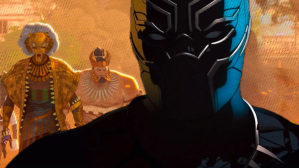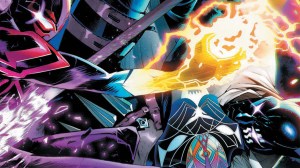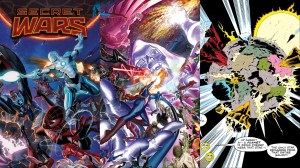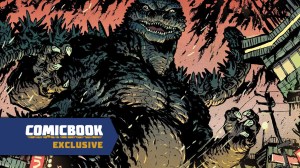
I read “Black Panther” #1 (nee #173 somehow), and I have mixed feelings about it. I think it’s a good comic, but that something happened in my reading of it that threw me off. And it’s not necessarily the creators’ fault.
Videos by ComicBook.com
I have a few theories on that I’d like to share, in the interest of transparency.
“Black Panther” #1
I haven’t read a “Black Panther” comics since Christopher Priest’s run on the title a while back.
But I have a soft spot for a good space comic, and the new “Black Panther” seemed to promise that. Just flipping through the issue, I saw all the trappings of stuff that I’m a sucker for: spaceships, people in futuristic garb, a man on the run, gunfights, high tech stuff, and alien creatures.

Sure enough, there’s a chunk of this issue that’s exciting and fun to read. A man runs for his life, fights the soldiers who are trying to take him back, works in the mines, and fights the bully who’s trying to keep him in his place, etc. Much of the action parts are silent, relying on Daniel Acuña’s art to tell the story, which he does well.
It’s Not Black Panther; It’s Me
The problem I always have with these new worlds in science fiction stories is all the new names. There are new people in new places, and often they come with their own jargon and tech babble to speak. It can be confusing.
Ta-Nehisi Coates’ script keeps the tech babble and place names to a minimum, but there are lots of new names for people and races, still. I wish some of it was clearer, to be honest. On a second reading, it all made sense and I had no problems. There’s a text page at the end that spells it all out for you. That would have been a show-stopper to include during the story, obviously.
I’m also not sure how many of those problems on the first reading came from me maybe reading too fast, and how much of it comes from having so much thrown at me so quickly.
Part of it, for sure, was also my own doubt that I was missing something because I hadn’t read the previous “Black Panther” series. Wakandan names were more of a distant memory, and what if this story was set up earlier in a previous story I hadn’t read?
Was it my fault that I didn’t know anyone?
I don’t think so, in the end. This is a fresh jumping-on point, as we like to say. It’s only my own second guessing that lead to any confusion.
The other way to look at it is that this probably a five or six issue story arc. In that context, the first act of the story — roughly the first issue or two — is where the author is trying to load the reader up on all these new things. It’s natural to be a little lost or confused. You’re still learning this world.
In the grand scheme of this story arc, any initial confusion is to be expected and will smooth over in the coming months.
One more potential angle: This story is about a slave whose mind is wiped and doesn’t know who he is or where he came from. Perhaps any feeling of being lost on the reader’s part is a sympathetic reaction to the main character’s feeling. In that case, good job!
The Art of Acuña
Daniel Acuña’s the artist here. I haven’t read any of his stuff in years, but he’s still got it. His storytelling is great. He can move his camera around to break things up and still tell the story cleanly. The sequence that stood out the most to me is the one where the unnamed slave gets shot down while on the run. Acuña chooses the perfect low angle for that sequence so you can see the character stumble and fall.

The technical production of his art is also inviting. Characters are instantly recognizable, and there’s enough detail in the backgrounds to give the characters places to move around in. Some angles are a little tighter than necessary, which helps hide more background details, but you don’t notice that so much in the heat of the moment.
He’s also doing some fun stuff with textures and patterns. It looks like something out of Photoshop or Clip Studio Paint, so I’m going to assume he’s working digitally. He’s doing his own colors, though, so it could be traditional pen and ink with that texturing added in the coloring process. It works, particularly in the dirty sci-fi world this book is set in.
Carry On?
I’m going to give this series another couple of issues to see how it goes. If Acuña stays on as the artist for the full story arc, and Coates can use what he’s built in this first issue to continue to tell an action packed sci-fi story, I’m going along for the ride.
When all is said and done, hopefully I’ll be able to look back at this first issue and see just what it was that threw me off. It’s probably me. Even the most stringent of reviewers has a bad reading day. The trick is in recognizing it and owning up to it.
PipelineComics.com|| Twitter || Instagram || E-mail || YouTube





